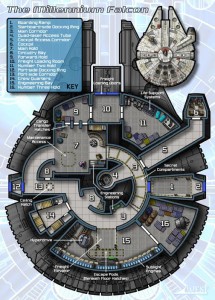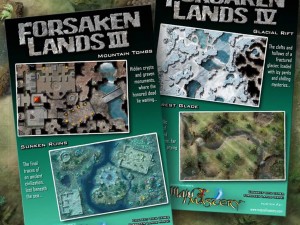
Today we’re excited to bring you an exclusive interview with renown RPG Cartographer, Christopher West.
 How did you get into the RPG map industry? Is that even something you can get into or did you create your niche?
How did you get into the RPG map industry? Is that even something you can get into or did you create your niche?
It was a case of being in the right place at the right time with the right kind of stuff.
At Gen Con in 2000, as the 3rd Edition of D&D was making its debut, I showed up with a portfolio of mostly full-color maps assembled to try and get work in the gaming industry. WotC head cartographer Rob Lazzaretti had seen some of my work via the Internet and given me a great deal of encouragement, so I traveled to Milwaukee ready to show my maps to anyone who would look at them. Nodwick creator Aaron Williams took some time to look them over, gave me a glowing review, and pointed me in the direction of Dungeon editor Chris Perkins.
Well, as it turns out, Dungeon Magazine was in the process of switching over to full color printing with the release of the new edition. Chris must have liked what he saw in my portfolio, because he quickly began sending me cartography jobs for Dungeon, and even bought one of my portfolio pieces (a black and white tower map, oddly enough) to turn into an adventure.
Soon Rob Lazzaretti sent me some work for the RPG line, as well, and my career was born.
Do you do other art besides maps?
I do, but I’m not nearly as practiced at it. My degree is actually in graphic design, though, and I’ve done some package designs for Gamer Nation Studios for the Eons and Edition Wars games. I’m very proud of how those turned out, and it’s always a pleasure to practice some of those design skills that I don’t get to use as often.
What was the first map you ever drew?
Honestly, I couldn’t say. I’ve been making maps as long as I can remember. Back in grade school I would create side-view dungeon tunnels and pits with ropes, snakes, and other various hazards, and then place a sheet of paper with a hole over it and let my friends explore them in a sort of makeshift board game. I don’t know who invented that concept, but it—along with Dungeons and Dragons and the works of Tolkien with his hand-drawn maps—fired up my imagination and love of visual exploration and world-building.
The first map that I would describe as professional in quality was a starship I built to teach myself the style of the cartography WotC used in the Alternity Player’s Handbook. That’s the one that got Rob’s attention and became the first piece of my portfolio.
What was the first map you were ever paid to draw?
The first map that anyone purchased was that tower from my portfolio, but I think my first paid job based on someone else’s art order was a set of tactical diagrams for Rich Baker’s Warships sourcebook for Alternity. It never saw print, but it was published as a free PDF for fans–and it still means a lot to me because that project allowed me to do professional work in the product line that inspired me to try doing professional work.
How many different systems have you worked/made maps for? Which is your favorite?
Wow. Let’s see. I’m going to forget a lot if I try to list them, but here goes: I’ve done work for Dungeons & Dragons, Pathfinder, multiple third-party d20 variants, Mutants and Masterminds, d20 Modern, Star Wars d20, Star Wars Saga Edition, Star Wars Miniatures, D&D Chainmail, Axis & Allies, Warlords of the Accordlands, Iron Kingdoms, Primeval Thule (D&D 4E, 13th Age, and Pathfinder), Numenera, and probably half a dozen others.
Picking a favorite map would be like choosing a favorite child, but I will say that the Lands of Mystery poster map I made for the final print issue of Dungeon Magazine was my personal thanks and farewell to readers for their support, and a map that combined all of my Maps of Mystery from the magazine into a shared world–so it holds a special place of honor.
Picking a favorite game system would depend on when you ask, because it tends to change, but right now I’m enamored of the Star Wars Edge of the Empire RPG—which I’ve actually never been asked to work on professionally.
What inspired you to start Maps of Mastery?
Before WotC gave up the Star Wars license, my main source of work—and thus, income—was the Star Wars miniatures game and the Star Wars RPG. So when that work was no longer available, I had to rethink my business strategy. Freelance work suddenly wasn’t paying the bills, so “Plan B” involved selling maps directly to players. I took the Star Wars-specific elements out of my work, began my own mapmaking business. The miniatures game players still wanted maps compatible with their no-longer-supported game, and RPG players have a steady need for high-quality tabletop maps compatible with miniatures. It worked, and I’ve been running with “Plan B” ever since.
What is your personal favorite map you’ve made?

The Millennium Falcon. Back when Polyhedron was publishing official, Lucasfilm-sanctioned content for the d20 Star Wars roleplaying game, I was given the opportunity to write a seven-page article about the Secrets of the Falcon, and create a new, official deck plan that reconciled all of the partial maps and variations that had been published over the years, AND elaborate on the ship’s history to an extent that I don’t think anyone one had ever been able to approach before. That map has since been used as the basis of every official Millennium Falcon product published, and things that I added to the history through that article went on to be referenced in novels and other tie-in materials. That remains the highlight of my career.
What was your first Kickstarter campaign? Why did you decide to give that platform a try?
My first Kickstarter campaign was for the Mass Transit II poster, a followup to my first self-published poster. The original Mass Transit poster was successful, but neither it nor the first Forsaken Lands poster was really profitable for a long time because they took a lot of money out of pocket to get printed. By using Kickstarter as a sort of no-risk preorder platform (if a Kickstarter project doesn’t reach its goal, no money changes hands at all), I was able to gauge interest and produce a new product that was ready to print and already paid for from the moment the campaign was complete. Forsaken Lands II followed, and now this ninth campaign hopes to bring several new maps into print, AND reprint those previous projects in order to build new, boxed Deluxe Sets with additional map content.
Tell us about the idea behind Forsaken lands series.

The Forsaken Lands maps are designed to be genre-neutral, which is to say that they should be at home in many different RPG genres. Whether your in a sci-fi game, a fantasy game, or a modern game, there will always be caves to explore–or barren canyons, or swamps, or forests, or…you get the idea. That’s not to say that the maps might have an individual leaning one way or another, but even if the statues in the Mountain Tombs closely resemble dwarves, they’re ambiguous enough that they might actually be Sith Lords…
Do you have any advice for future cartographers?
I have three main pieces of advice that have served me well:
First, use the tools that you know. I like Photoshop, but if your experience is all in some other tool (software or physical media) that you’re comfortable using, you’re going to make your best work in that. Only switch platforms if there’s a feature you need that your most familiar tools don’t have.
Second, strive to be better than the artists that currently make the best examples of the kind of work you want to do. Figure out how to make art like that, and then figure out how to improve on it. This takes time, practice, and commitment, but if you have the drive to be the best, your work will continue to improve. Never settle for “good enough.”
Third, when you’re ready to look for professional work in an industry, do NOT start at the bottom (the least known or lowest-paying publishers) and expect to work your way to the top (the industry leaders). It’s hard to lose a reputation of being willing to working cheap, and the better-paying clients don’t exactly look to those publishers for hot new talent. Instead, start at the top and work your way down until you find work. Approach the industry leaders with your portfolio, tailor it to the kind of work they need, and listen to what they tell you. If you don’t get work there, approach the next-biggest publisher, and so on, until you do. Then, once you have a foothold and have proven your ability to meet deadlines and deliver quality work, you can begin your climb to the big leagues.
Thanks Chris! Check out Maps of Mastery to see more of Chris’ impressive work and back his Kickstarter for his new Forsaken Lands maps.
Wayne Basta
Latest posts by Wayne Basta (see all)
- X-Wing Tier List – Rebels - May 10, 2023
